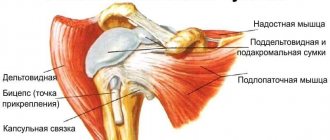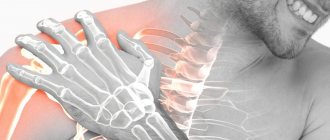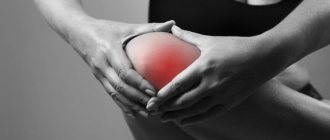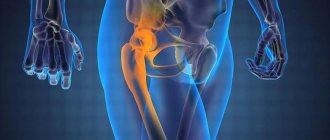27.11.2020
The shoulder joint is susceptible to injury due to its anatomical features and functions. The most common possible shoulder injuries are:
- bruises and dislocations;
- intra-articular fractures;
- sprains and ligament tears.
Ligaments are the most susceptible to injury because they control joint movement. Their purpose is to limit joint movements during unnatural and dangerous movements and ensure minimal risk of injury. Ligament injuries are often caused by exceeding permissible loads.
A shoulder ligament injury involves excessive stretching or partial tearing of the fibers. The damage is of a closed mechanical nature. Due to a ligament injury, some movements may be limited or cause pain. In this regard, it is recommended to seek qualified help as quickly as possible if you suspect that not everything is in order with the ligaments.
Causes of ligament damage
The most common injuries to the shoulder ligaments occur in athletes. Due to excessive stress on the joints, the strength of the tendons is reduced, which leads to stretching or rupture.
But shoulder ligaments can be damaged not only by playing sports. Injuries also occur in everyday life, in accidents. For example, tears and sprains occur with sudden movements, twisting the arm outward, falling on the upper part of the shoulder or outstretched arm, hitting the front of the shoulder, etc.
But sudden movements of the hands or strong blows do not always lead to damage to the ligaments. In many cases, additional factors that contribute to the weakening of the tendon-muscular system play an important role, for example:
- age - over time, ligaments lose their properties, the likelihood of damage increases;
- osteophytes - growths that affect bone tissue;
- metabolic disorder;
- poor nutrition – due to a lack of vitamins and other nutrients, the condition of the ligaments may worsen;
- excess weight – increases the load on the joints;
- lifestyle - smoking or drinking alcohol can affect the elasticity and firmness of the ligaments;
- the presence of a disease that requires hormonal therapy;
- birth defects, joint abnormalities, etc.
Injuries associated with sprained or torn ligaments of the shoulder joint are a fairly common type of injury, regardless of the patient’s age.
Types, stages and forms of shoulder tendonitis
To determine the type of pathology, the localization of the source of inflammation should be taken into account. Most patients are diagnosed with supraspinatus , and treatment in this case should be aimed at strengthening the tendon.
There are also the following types of pathology:
- Tendinitis of the head of the biceps shoulder joint . Localized in the tendon area between the shoulder and biceps muscle;
- Tendinitis of the rotator cuff tendon . Provokes pain and inflammation in the immediate vicinity of the cuff. Usually occurs against the background of increased physical activity.
There is another type of disease - calcific tendinitis of the shoulder joint, which is identified as a separate item, and the treatment of this disease should be selected taking into account its form:
- Reactive. The deposition of calcifications is caused by injury, infections and excessive physical exertion;
- Degenerative. The accumulation of calcium salts is associated with age-related factors and deterioration of blood flow in the joint area.
The above form of the disease is characterized by three stages of development:
1. Precalcification. The conditions for the appearance of calcium deposits are formed under the influence of risk factors.
2. The appearance of calcifications. Calcium crystals enter the tendon fibers and settle.
3. Postcalcification. Characterized by the replacement of tendon tissue with scar fibers.
Moreover, there is chronic tendinitis of the shoulder joint, and its acute form , which necessitates treatment adjustments.
Symptoms of a sprained or torn ligament
When the shoulder ligaments are damaged, the following symptoms often occur:
- shooting pain in the shoulder when moving your arms up or to the side;
- swelling in the injured area - usually a couple of hours after the injury;
- increased temperature on the surface of the edema;
- hematomas and tumor;
- limited shoulder mobility.
If a child is injured, the joint may move unnaturally, which is also a symptom of a sprained or torn ligament.
Pain is the main symptom that appears immediately after injury. Over time, the pain may change to aching or dull.
To provide first aid if a ligament rupture or sprain is suspected, it is necessary to immobilize the injured limb and apply a cold compress. If the pain is severe, the victim can be given a painkiller. After which it is necessary to take him to the hospital.
It is not recommended to treat joint ligament injuries on your own - this can be dangerous for the injured arm and lead to negative consequences.
Diagnosis of shoulder ligament lesions
To properly diagnose an injury, a doctor needs to know the symptoms, timing, and circumstances of the injury. For an accurate examination, it is important to establish the nature of the pain in order to determine the extent of ligament damage. The specialist may also ask about past injuries, if any, and methods of treating them.
When examining the patient, the specialist determines:
- presence and degree of edema;
- degree of shoulder mobility;
- intensity of pain.
In order to exclude the presence of dislocations, cracks, fractures and other mechanical damage, the patient may be prescribed an X-ray examination. It is done when the doctor suspects that the shoulder ligaments are injured.
Additional diagnostic methods are usually used:
- arthroscopy – minimal surgical manipulation using special equipment;
- Ultrasound – examination using ultrasonic waves;
- MRI – visualization of a joint using a magnetic field.
Only a specialist can correctly determine the nature and extent of damage to the shoulder ligaments. In addition, the symptoms of their sprains are similar to other possible shoulder injuries, so it can sometimes be difficult to determine what kind of injury the victim suffered.
Treatment of shoulder ligament lesions
First of all, it is necessary to exclude any movement of the shoulder joint. It is advisable to apply a fixing bandage for a while so that the shoulder, tendons and ligaments are in a state of calm.
As for medications, the doctor usually prescribes painkillers to reduce pain and swelling, as well as vitamins. The diet must be balanced - the treatment process will speed up if you add hyaluronic acid, chondroitin and glucosamine to the diet.
In more severe cases, they resort to procedures such as:
- cold compress on the damaged area;
- limb fixation;
- electrophoresis with anti-inflammatory drugs;
- magnetotherapy – a procedure using a magnetic field;
- balneotherapy – treatment with mineral waters;
- paraffin therapy is a method of heat treatment using paraffin.
Surgery is usually not performed for sprained or torn shoulder ligaments. They are indicated only in rare cases, for injuries with complications.
As the final stage of treatment, the patient needs to undergo a massage session in order to fully recover from the injury. Health-improving physical education with control of moderate loads is also recommended.
To prevent injuries to the ligaments of the shoulder joint, it is necessary to exercise regularly, control nutrition and weight, observe the necessary technique during training, etc.
Treatment of shoulder tendinitis
To figure out how to cure tendinitis of the shoulder joint, it is necessary to take into account the factors that provoked the development of the pathological process, as well as its form and stage of development. For example, if you have been diagnosed with tendinitis of the supraspinatus muscle of the shoulder joint, and you do not know how best to treat it, then you should turn to the causes of the disease. If it was provoked by injury, then the only correct solution would be surgical intervention, as in the case of detection of adhesions in this area. In mild forms of the pathology, you can completely resort to conservative therapy.
However, in almost all cases of shoulder tendonitis, treatment involves limiting your physical activity for a certain period of time. In this case, a special splint or bandage is used to fix the limb. To relieve pain when injured, ice is applied to the injury site.
SWT for the treatment of shoulder tendinitis
Many patients are interested in: “How to treat shoulder tendinitis without surgery?” Indeed, today such a possibility exists: an excellent restorative effect is achieved using shock wave therapy. This is a modern way to eliminate most ailments associated with dysfunction of the musculoskeletal system.
The effectiveness of this newest method is aimed at achieving the following results:
- Relief and complete elimination of pain;
- Crushing of calcium deposits in tendons;
- Activation of metabolism;
- Normalization of the blood circulation process;
- Complete elimination of inflammation;
- Restoring motor activity and healthy tissue.
Lasting healing results are monitored from the first sessions of shock wave therapy. Moreover, their frequency and intensity are determined individually. Also, the effectiveness of the procedure in 90% of situations is influenced by the timeliness of visiting a specialist.
At the Health Plus clinic, shock wave treatment is carried out using innovative Swiss equipment, under the guidance of experienced neurologists and physiotherapists, and at competitive prices. We also provide a 20% discount on the initial visit to a specialist.
Read more about treatment of tedinitis with UVT »
Drug treatment for shoulder tendinitis
If you have shoulder tendonitis, treatment with medication is an integral part of a speedy recovery. In this case, non-steroidal drugs are used, the action of which is aimed at relieving pain and eliminating the inflammatory process. In the normal course of the disease, experts recommend taking medications in tablet form; in case of severe injury, injections are prescribed.
The best effect can be obtained by taking Diclofenac, Ketoprofen, Meloxicam and Ibuprofen for one week. Also, to relieve discomfort, you can use special ointments with anti-inflammatory and analgesic components (Nise-gel, Voltaren, Diklak, etc.).
In severe forms, it is recommended to give injections in the area of tendons and muscles with the following drugs:
- Dexamethasone;
- Kenalog;
- Hydrocortisone.
If there are concomitant diseases associated with infection and inflammation of the joints, or elevated blood sugar levels, they are initially treated. Otherwise, it will be impossible to get rid of the symptoms of tendinitis.
Physiotherapeutic methods
Mandatory measures to eliminate the above pathology include physiotherapeutic procedures. With their help, it is possible to normalize blood flow in the affected area, as well as enhance metabolism in damaged tissues and the surrounding area.
At the same time, electromagnetic radiation provides a special positive effect: the process of tissue restoration in the affected areas is accelerated and pain is relieved. Magnetic therapy has a similar effect on the patient, which is allowed even in severe stages of the disease.
Another effective treatment method is laser therapy. Through the use of such innovative techniques, it is possible to quickly relieve discomfort in the limb and increase metabolism.
To enhance the therapeutic effect, the patient may be prescribed phonoresis or electrophoresis, during which the following drugs are recommended:
- Corticosteroids;
- Anesthetics;
- Analgesics;
- Non-steroidal anti-inflammatory drugs;
- Angioprotectors.
If the patient is indicated for shock wave treatment, then to achieve a lasting effect it is necessary to undergo 8-10 sessions over four weeks. This will eliminate swelling, as well as deal with calcium deposits and adhesions in the tendon area. Paraffin therapy and medicinal baths also allow you to get the desired anti-inflammatory result.
Treatment of shoulder tendinitis with folk remedies
To quickly achieve a healing effect for tendinitis of the shoulder joint, you can resort to treatment with folk remedies. However, such measures should only be implemented in addition to the basic procedures. Next, we will talk about the most popular home remedies for eliminating the disease. These include:
- To achieve a powerful absorbent effect, it is recommended to use chopped raw potatoes. For this purpose, the finely grated mass is placed in a cloth and applied to the lesion for 3 hours;
- For rubbing, use a mixture of crushed garlic and eucalyptus oil. The above components are preheated in a water bath and left to infuse for 24 hours;
- A mixture of sea salt and onion juice is ideal for massage;
- To ensure an anti-inflammatory effect, a small amount of turmeric should be added to your daily diet;
- To relieve puffiness, it is useful to regularly consume bird cherry berries;
- A particularly positive result can be obtained by rubbing the affected area with an infusion of walnut partitions (50 g of partitions are infused in 1 glass of vodka for 10 days).
Exercise therapy for shoulder tendinitis
In any situations associated with inflammatory processes in the tendon area, it is recommended to undergo a complex of exercise therapy. In this case, only small loads are allowed, which eliminates the possibility of deterioration of the patient’s condition. As a rule, the physiotherapist offers the patient a program developed individually and monitors the exercises at the initial stage.
In general, exercise therapy for shoulder tendonitis includes the following set of exercises :
- Place both hands on the ends of the towel draped over the bar. Pull it with your healthy limb, carefully lifting the damaged one;
- The palm of the damaged arm is placed on the biceps muscle of the healthy arm, smoothly raising the elbow upward;
- Take a gymnastic stick, grasp it with both limbs, place it in front of you and perform circular movements clockwise;
- Place your hands in a lock and carefully lift them, fixing them in front of you;
- Make movements with the affected limb similar to a pendulum.
In case of exacerbation of the disease and deterioration of the patient’s condition, the exercises recommended for tendinitis of the shoulder joint must be temporarily suspended. If the undesirable manifestations go away, the course of exercise therapy can be repeated.
If you have completed standard activities, and the question is: “How to treat shoulder tendonitis?” remains relevant and you continue to be bothered by discomfort, stiffness and swelling, the only effective method will be surgical intervention. As a rule, in such situations, an arthroscopic puncture is performed, which does not require a long recovery period.









